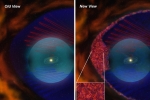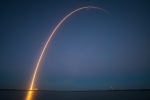The Milky Way's Last Major Black Hole Eruption Occured 2 Million Years Ago, Astronomers Say
A team of scientists have determined that the giant black hole at the center of the Milky Way last erupted two million years ago. The black hole, which is as massive as four million suns, has been dormant ever since. It does still swallow up some stellar material that gets pulled into its path, and emits small amounts of radiation as a result, but not on a significant scale.
Like Us on Facebook
"If we had been around to see it two million years ago, the situation would have been very different," said study co-author Philip Maloney of the University of Colorado in Boulder. "The Milky Way's black hole was maybe ten million times brighter [then]....I don't think anyone really had any expectation that [the black hole]might vary in luminosity by such a huge factor on such a short -- relatively speaking -- time scale."
The study, which will be published in The Astrophysical Journal, builds on bits of evidence that have been gathered over the years regarding the Milky Way's black hole. In the 1970s, astronomers discovered the Magellanic Stream, a giant gas cloud made up of dwarf galaxies orbiting the Milky Way; in the 1990s, scientists realized that the Magellanic Stream glows faintly, leading them to wonder just where that light might be coming from.
Maloney and his team think that the answer lies with the black hole. They believe that two million years ago, energy erupting from the black hole caused hydrogen gas to ionize in the Magellanic Stream. The Stream's glow, still seen today, is similar to a fossil record.
"For twenty years we've seen this odd glow from the Magellanic Stream," said Professor Joss Bland-Hawthorn of the University of Sydney, Australia, who led the study team. "We didn't understand the cause. Then suddenly we realised it must be the mark, the fossil record, of a huge outburst of energy from the centre of our Galaxy."
The astronomers created geometric models to determine how long a radiation explosion would take to travel from the black hole to the Magellanic Stream, and how long it would take for the resulting glowing light of the Stream to be visible on Earth. The conclusion was that the eruption took place two million years. They also found that the amount of energy required to make the Stream glow could only come from a radiation source as massive as the black hole.
Scientists think there will be another eruption from the black hole like the one that occurred two million years ago, though they don't know when. Astronomers have pinpointed one relatively small object that may get sucked into the black hole sometime soon.
"[Astronomers] have been monitoring a cloud and predict that it will fall into the black hole at some point in the next year; however, the amount of material will be far less than the event that illuminated the stream," said study co-author Greg Madsen of the University of Cambridge. "It will be much fainter and will pose no threat to Earth, but several powerful telescopes will be poised and ready to watch what happens."
READ MORE:
How Old Is The Moon? 100 Million Years Younger Than Previously Thought, Says Researcher
The Sun Will Destroy Life On Earth In 1.75 Billion Years By Drying Up The Oceans, Researchers Say
© 2012 iScience Times All rights reserved. Do not reproduce without permission.

25 Year Study Reveals Eco-Farming To Be Economically Feasible And Sustainable

How Methane-Producing Microbes Caused The Largest Mass Extinction The World Has Ever Seen

Terrifying Animatronic Robot Dances To 'Blurred Lines,' Causes Nightmares [VIDEO]

Scientists Demonstrate Three-Way Quantum Communication: What's Faster Than The Speed Of Light?

Woolly Mammoth DNA To Be Cloned, Then Joined With Elephant DNA To Create New Creature

Oculus Rift Headset Will Take You On A Trip To Space, All From The Comfort Of Your Couch



![How to Turn Your Tap Water Faucet Into a Coffee Spout [VIDEO]](../../../cdn-sub/data/thumb/mainpage/6005-150100-coffee.jpg)

